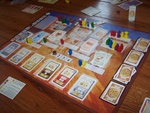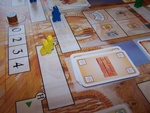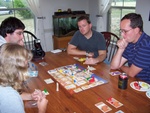
|
Leonardo da Vinci A game by Stefano Luperto, Antonio Tinto, Virginio Gigli and Flaminia Brasini Published by daVinci Games and distributed in the US by Mayfair Games, Inc. Players: 2-5 Time: 60-90 minutes Reviewed by Susan Rozmiarek |

|
Leonardo da Vinci is a strategy game by Acchittocca, a team of Italian game designers and is co-published by daVinci Games and Mayfair Games. Players are Renaissance inventors in Florence, Italy and compete to finish inventions and reap the monetary rewards. The player who collects the most Florins is the winner.
I have played this game three times now and feel that I have not quite gotten a good grasp of it. There are still a lot of strategies I need to explore. Because of this, I feel a little trepidation at trying to write a thoughtful review. However, the game is too frustrating and has a little too much player interaction for my tastes and I don't expect to play it very often so I may never get comfortable with it. Since it is quite an impressive and interesting game that is likely to please many people, I'm going to give a review my best shot.
Components:
Each player has, in his player color, the following things:
- 1 wooden Master
- 9 wooden apprentices
- 2 wooden work counters
- 2 double-sided laboratory tiles
- 60 component cards, 12 each of the five types
- 25 invention cards
- 60 Florin cards in several denominations
- 2 summary tiles
- 1 wooden money marker
- 1 wooden turn marker
- 15 mechanical men tiles
- 4 invention marker arrows
- Leonardo tile with plastic base
- 1 Lord of the City with plastic base: There is no mention in the rules on what he is used for but it is to mark which location on the board is being resolved
- Game board, depicting the city's various locations
- Rulebook
Game play:
Setup
At any rate, players start with a master and some apprentices, some florins, one or both of their laboratories, and some components. The invention deck is shuffled and stacked as explained in the rules, another rather fiddly part of the setup. The end result will be that the more valuable and difficult inventions will be toward the bottom of the deck.
The game board is placed in the center of the table. Along the left side there is place for keeping track of the turns, along the right side there is a bank where the florin cards are placed and along the bottom, five invention cards will be placed. These are the current inventions that are requested. The rest of the board depicts the locations where players will be deploying workers during each round. These are the Workshop, where players get another lab, upgrade a lab or get mechanical workers; the Council, where players can take special actions; the Academy, where players get more workers; and finally, a shop for each of the five different components. Players' labs and workers not obtained in the setup go in the appropriate locations on the board.
The game lasts 9 turns with turns 1-7 going through the following phases:
Laboratory Phase: Players secretly commit to working on a particular invention by placing the necessary component cards facedown under their laboratory(s). The number and type of resources remains secret from the other players. Players may also cancel work in a lab and take the component cards back in their hand. A lab can only work on one invention at a time and it must either be one of the requested inventions on the board or one that hasn't been turned up yet. Inventions require two things to complete which are indicated on the card - components and time.
Assignment Phase: Players send apprentices to various locations on the board to upgrade their lab, get more apprentices, and collect the various types of resources. These are all little once-around auctions going on simultaneously with apprentices as the bidding currency. On your turn during this phase, you may place any number of apprentices on a location. The catch is that you can never add more to that particular location that round with the exception of your master or vice versa. You can also place apprentices on your laboratories to perform weeks of work. This goes round and round until everyone's apprentices have been placed. This is quite a neat mechanism as it doesn't feel like a bunch of auctions. Rather, it feels like you are sending out your men to their work assignments.
Employment Phase: Each area on the board has a letter and they are resolved in alphabetical order. Areas are resolved by first looking at the number of apprentices there. The person with the most gets to act first, the second most chooses next and so on, with ties being broken in favor of the person who placed workers first.
The council is resolved first and it is a little different than the others. There are five different actions and there is no cost to take one. Players who allocated workers here may choose one single action and no other player may choose that action this turn. The action is taken immediately. In addition, the first player to choose also gets to choose who will be the next starting player. The actions are:
- Move one of your apprentices to another city area
- Take all the Florins in the Council (one Florin is added at the start of every game turn)
- Secretly look at and re-order the top four inventions in the invention deck
- Pay one Florin to take the component of your choice
The rest of the locations are similar in that in each there are four chances to get a benefit with an increasing cost. The first player to choose gets the benefit for free then the cost increases to two, three and finally four Florins for subsequent benefits. The workshop allows players to purchase their second lab, upgrade one of their labs by flipping it to the reverse side, or taking a mechanical man to place on a lab. The Academy allows a player to take one of his workers there (if there are any left) and place it in his supply. Each shop allows a player to take a component there.
After resolving the areas on the board, research is conducted in all labs that have workers and/or mechanical man. On each lab, there is a track to mark the time. Each worker and mechanical man in the lab moves the maker forward one space and a Master moves it forward two.
Research Phase: Players announce if they have completed any inventions and receive payment in Florins. If they are the first to complete the invention (and this can be more than one player), they get the larger amount of florins listed on the card. If only one player has completed the invention then he gets to take the card but if more than one player completed it, there is a close-fisted auction using Florins to see who gets it. Why would one want an invention card? Each card has one of five different types of symbols on it. For each card you have of a particular symbol, the time cost for subsequent inventions of that type goes down. For collections of cards with different symbols, there are some nice endgame bonuses ranging from 8 Florins for 3 different types to a whopping 20 points for all five types. This made for some interesting decisions as to what inventions to go for and presents two different strategies. It also creates even more pressure to finish inventions as quickly as possible so as to be able to get the card.
Players that are still working on an invention completed by another player can still continue working on it. They take one of the arrows and place it near them pointing to the player who gets the invention card. The arrows are another little part of the game that felt fiddly and did not seem necessary. We found it easy to remember what inventions we were still working on. When they finally do complete the invention they will receive the lesser amount of Florins on the card.
Game end: The last two rounds of the game are for research only and play very quickly. Workers are allocated on labs only and no new invention cards are turned over after the eighth round. After the ninth round, bonuses for different types of inventions are awarded and the player with the most Florins is the winner.
Comments:
This is one of those games where players build a game "engine" that eventually cranks out the desired product for victory.
Similar games include Princes of Florence, The Scepter of Zavandor and Roads & Boats.
In Leonardo the engine is built by upgrading labs, and getting more apprentices and mechanical men.
This will enable players to complete the more valuable inventions that come out toward the end of the game.
To do this you will have to spend the Florins that you are trying to save to win the game which creates many tough decisions.
The game takes a lot of planning as it seems to race quickly towards these last two turns and in fact feels a bit rushed
as it seems to end just as you get going.
It is imperative to have set yourself up by the end to be able to research and complete a valuable invention in those last turns.
The components and enough workers need to be in place on upgraded labs in time.
All this makes for a lot of tension and competition during the game.
Usually, I really like this sort of game. I enjoy having variable strategic paths to choose from and I enjoy the planning and resource management involved. However, a few things in this game bothered me enough to kill my enjoyment:
- In all three of my games, there was an immediate race to get workers from the academy that dominated the first turns of the game, even with players who started with more workers. I'm not sure what the consequences of falling behind on your bidding power would be, but nobody wanted to find out. At only three games played though, I'm willing to admit that this may be an aberration with our group and we need to explore other approaches.
- The level of player interaction was a little high for my tastes. In similar games, I will often opt to stay out big battles over things and instead try to pick up less contested things cheaply and see what I can do with them. That did not work in Leonardo as everything seemed to be fought over tooth and nail, especially in the five-player game. Some players are really going to enjoy this aspect. For me, it is a little too much in a game that requires so much planning ahead. I prefer the more solitaire play of Princes of Florence or that of Roads and Boats where you can implement at least part of your plan somewhat before other players can mess with you much.
- Perhaps my biggest complaint, though, was the secret nature of the inventions players are working on. Even as I tried to watch what resources other players were purchasing, I found it very difficult to guess which inventions they were working on before committing my own labs. Players that guessed correctly had a huge advantage, collecting the invention card unopposed while other players had fight over their completed inventions spending precious Florins. This was a huge factor in my games and it really did often seem to be a guess.
By itself, any one of these complaints is not enough to kill the game for me but taken altogether, each of my experiences were extremely frustrating and left me feeling like I was woefully inefficient and had played badly. So, while I'd like to experiment and try a few different approaches to the game, it is not one that I'm likely to suggest. I probably won't have to though, since several in my gaming group seemed to enjoy it quite a bit.
This is the most ambitious game from daVinci that I've seen yet and departs from their usual lighter fair into the realm of deeper, more strategic games. Not only does this game require careful planning, it also has a lot of player interaction. It is definitely more for the serious rather than casual gamer. The fact that many people were involved in its development shows in that it had many working parts that mesh together well and fit the theme. That said, I simply did not enjoy it much for the reasons stated above which are probably partly due to my individual tastes rather than any flaw with the design.
| Other Web information: |
This page viewed
E-mail Ed Rozmiarek with questions or problems concerning this page.
Copyright © 2007, Ed & Susan Rozmiarek. No portion of this website may be reproduced or copied without the consent of Ed or Susan Rozmiarek.






